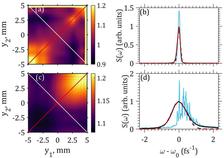Difference between chaotic and coherent light sources. (a) photon correlation map for FERMI operated in seeded mode. (b) corresponding spectrum. (c) correlation map for FERMI operated in Self Amplified Stimulated Emission mode (the mode of operation of most Free Electron Lasers). (d) corresponding spectrum. Reprinted from Original publication (Copyright Nature Publishing Group).
Pulsed lasers are intense and coherent light sources, and the latest category is that of X-ray Free Electron Lasers (FEL), such as FLASH and the European XFEL in Hamburg or FERMI in Trieste (Italy). It is well known that coherence leads to interference phenomena which are for example visible in the famous double slit experiment by Young (spatial coherence) and interferometer experiment by Michelson (temporal coherence). First order coherence of light sources, which is manifested for example in diffraction phenomena, represents the correlation between the amplitudes of a wave at different points in space (transverse (spatial) coherence) or time (longitudinal (temporal) coherence.) However, a high degree of first order coherence is not enough to define a laser, according to the 2005 Nobel laureate Roy Glauber, who stated that a laser can be defined as a source that is coherent in all orders. The higher order correlations are between intensity at different points in time and space. How are these correlations measured? For this one has to look at the statistics of the photons.
Glauber’s work was inspired by the famous Hanbury Brown and Twiss (HBT) experiment, in which coincidences of photons (i.e. correlations) were measured of light coming from distant stars. By varying the distance between two detectors, they were able to determine the degree of coherence of the star, and extract other information. This is the key to measuring the second order coherence of a light source: the intensity of light at different points is measured in coincidence, and statistical analysis is made. The first HBT experiment at a free-electron laser was performed at FLASH by a team around Ivan Vartaniants from DESY and the National Research Nuclear University Moscowin 2013. Instead of the two discrete photodetectors measuring the simultaneous arrival of photons used originally, a CCD detector was used. Since all of the photons arrive in less than 100 fs due to the ultrashort duration of the FEL pulses, there is no need to use coincidence methods: the signal is naturally synchronised. Now a team led also by Ivan Vartaniants has performed a similar Hanbury Brown and Twiss experiment at FERMI which is the first XUV and soft X-ray FEL that is externally seeded.
Measurements at FLASH and later LCLS, based on the Self Amplified Stimulated Emission (SASE) process, have shown that although these FELs are first order coherent, they are not coherent at higher orders. Thus they can be considered “chaotic” sources, according to the quantum interpretation of the HBT experiment, like stars measured by HBT. The measurements at FERMI showed that a seeded FEL is a different light source: it is not only first order coherent, as previously demonstrated, but also second order coherent, thus satisfying Glauber`s definition. This is an important result as it shows that the seed laser transfers all of the important properties of a laser, including the statistical and higher order properties, to the emitted light. As well, some quantum optical experiments require high order coherence, and so the way is now open for this class of experiment.
DESY is planning to implement external seeding at FLASH as part of the upgrade plans ‘FLASH2020+’ as soon as variable gap undulators will be installed in the FEL line FLASH1 in addition to second FEL line FLASH2, which is already equipped accordingly. This upgrade would make the light source to a ‘real’ laser according to Glauber`s definition. Moreover, FLASH would be the first high-repetition rate FEL that is externally seeded.
(partly from Fermi News)
Reference:
O. Y. Gorobtsov, G. Mercurio, F. Capotondi, P. Skopintsev, S. Lazarev, I. A. Zaluzhnyy, M. Danailov, M. Dell`Angela, M. Manfredda, E. Pedersoli, L. Giannessi, M. Kiskinova, K. C. Prince, W. Wurth, and I. A. Vartanyants “Seeded X-ray free-electron laser generating radiation with laser statistical properties”, Nature Communications 9, 4498 (2018), DOI: 10.1038/s41467-018-0678








